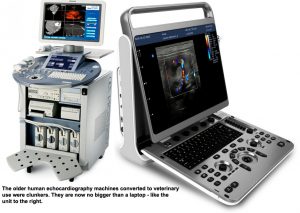Pulmonary Hypertension And Right Side Heart Failure In Your Dog
Ron Hines DVM PhD
 Congestive Heart Failure & Your Dog’s Mitral Valve
Congestive Heart Failure & Your Dog’s Mitral Valve
 Subaortic Stenosis In Your Puppy
Subaortic Stenosis In Your Puppy
What Is Pulmonary Hypertension And Right Side Heart Failure?
Pulmonary hypertension (PH/ PAH) is a term used to describe unusually high blood pressure in the blood vessel transporting blood from the right side of your dog’s heart to its lungs. That large blood vessel is its pulmonary artery. All blood returning from your dog’s body makes that journey to the lungs to replenish its oxygen content.
Ordinary or systemic hypertension (high blood pressure) describes the situation in which your dog’s blood pressure is abnormally high in the arteries and capillaries throughout its body – not just its pulmonary artery and the right side of its heart.
When your dog (or cat for that matter) develops pulmonary hypertension, the right side of its heart is working harder than it should have to to force unoxygenated blood to the lungs for oxygen replenishment and CO2 dissipation. Pulmonary hypertension is the result – not the cause – of a number of things that can go wrong when blood makes its circuit through the lungs to become re-oxygenated. (read here, here & here) No matter what the underlying cause or causes might be, restricted blood flow and abnormally high pressure on the way to your dog’s lungs eventually causes destructive changes in the shape of the right side of its heart. The upper and lower right portions of the heart enlarge (hypertrophy/ dilatation), and the two valves that prevent back flow (the pulmonary valve and the tricuspid valve) become distorted, failing to completely close and/or open satisfactorily.
Your local veterinarian might have told you that your dog has developed right-side heart failure, or a veterinary cardiologist might have used the term, cor pulmonale. They both describe the same problem.
What Are Some of The Causes Of Pulmonary Hypertension In Dogs?
Your dog’s oxygen-depleted blood returns to its heart through the largest vein in its body called the vena cava. The posterior portion of this large vein drains blood from all potions of its body from its tail to its heart (read here); while the anterior portion conveys blood to the heart from the pet’s head and neck. (read here) Any obstruction to this returning blood flow from the point where it enters your dog’s heart to the point where the blood leaves re-oxygenated from its lungs increases its heart’s workload and has the potential to eventually cause increased pressure (pulmonary hypertension) and right side heart failure.
Congenital Birth Defects
The most common of these genetically-based obstruction defects is Pulmonic Stenosis. Pulmonic stenosis (PS) is a defect in the one-way semilunar valve that guides blood from the right ventricle of your dog’s heart into the pulmonary artery that leads to its lungs. PS occurs more frequently in some dog breeds than others – particularly breeds with short snouts (brachycephalic breeds) like bulldogs, boxers and Boston terriers. But for unknown reasons it is also more common in Jack Russell terriers, Labrador retrievers, Samoyed and Newfoundlands than in the general dog population. When these blood flow restriction defects exist on the right side valve, not enough blood is able to pass through it. Different symptoms occur when the left side valve is affected (read here) Sometimes an abnormally narrow fibrous ring at the base of the valve (the sub valvular annulus) forms. In other cases the valve leaflets are thicker and less flexible than they should be, or they are fused together. Less commonly, it is the area just past the valve (downstream) that is narrow (the supravalvular area). The cause is genetic – a failure of the embryonic heart to develop properly. Any of these restrictions in right side blood flow cause the heart to force blood through the restriction at higher pressure, dilating the pulmonary artery and increasing blood pressure within it. With time, the increase in workload on the right side of your dog’s heart weakens its ability to pump sufficient blood to its lungs to be reoxygenated.
Since the defective genes involved regulate more than pulmonic valve development, it is not unusual for puppies with this problem to have a defective aortic valve as well. You can read about left side aortic valve stenosis here. The same or similar gene combinations occasionally causes the wall (septum) dividing the left from the right side of the heart to have a hole in it as well (a ventricular or atrial septal defect). (read here)
These birth defects come in all degrees of severity. Many result in heart murmurs that your veterinarian might pick up on (notice) during the physical exams given during your puppy’s early vaccinations. When these defects are mild, many dogs show no signs of ill health. When heart defects are multiple or severe, collapse upon exercise, bluish gums and tongue and failure to thrive are common. Veterinary cardiologists and interventional radiologists can attempt to stretch some of these strictures (blood flow restrictions) using a technique called balloon valvuloplasty. (read here & here) The procedure is delicate, and the long-term benefits are unknown. Great expertise is required by the surgeon and even then, these procedures are not always successful. (read here)
Lung Disease
Dogs with long-term lung disease that obstructs blood flow are also at risk of ultimately developing pulmonary hypertension and right side heart failure. The lungs are a vast network of small blood capillaries that expose left side heart blood to oxygen before returning the blood to the heart for recirculation. Anything that hinders blood flow within those lung capillaries increases back pressure (pulmonary hypertension) in the pulmonary artery and right side of the dog’s heart. A number of inflammatory diseases increase the wall thickness of the lung’s alveoli preventing normal blood flow and taxing the right side of the dog’s heart. (read here) Dogs with this problem have serious respiratory distress. They breathe rapidly and uncomfortably in an attempt to better oxygenate their bodies. X-rays of dogs with chronic lung disease (pulmonary veno-occlusive disease) show a patchy or diffuse thickening of their lung tissue. Similar issues occur in humans with obstructive lung disease. (read here & here)
Dogs with weakened immune systems are at increased risk of pneumonia. When pneumonia is a long-term issue, it too impedes lung circulation which can lead to pulmonary hypertension and right side heart failure. (read here)
Tricuspid Heart Valve Issues
The tricuspid heart valve divides the upper and lower right chambers of your dog’s heart. Like the mitral valve on the left side of your dog’s heart, the tricuspid valve is at risk of improperly closing (leaking/regurgitating blood) when the right ventricle forcefully contracts. In some right side heart issues, it opens insufficiently. In other cases it closes insufficiently. In some cases, both. When the mitral valve on the left fails, it is usually due to the wear and tear of time. When the tricuspid valve fails, the causes are often genetic. (read here) At other times blockages elsewhere in the flow of blood to the lungs cause ventricular pressure to be so high that the valve fails. (read here)
Heartworms
The preferred location of mature dog heartworms is in the pulmonary artery and right upper chamber (right atrium) of your dog’s heart. These worms kill their host through a combination of physical obstruction of blood flow and the lung inflammation they cause. Read about heartworm disease and treatment here and here. The inflammation these parasites cause in a dog’s lungs is called pulmonary endarteritis, an inflammation of arterial linings. It restricts lung blood flow and increases pressure within the lungs and pulmonary artery leading to pulmonary hypertension. (read here) When a large number of adult worms are present, that eventually leads to right side and then total heart failure. The problem is sometimes referred to as cor pulmonale.
Cats can also develop heartworm disease. Because their pulmonary artery is smaller, it only takes a few mature heartworms to be lethal to them. But what the parasites do to right side blood circulation and pressure is the same as what they do to dogs. (read here)
Left Side Heart Failure Leading To Right Side Heart Failure
One side of your dog’s heart cannot change in its shape or function without affecting the shape and function of the other side of the heart as well (=ventricular interdependence phenomenon). Other than when due to heartworms, heart failure begins on the left side of a dog’s hearts considerably more frequently than it begins on the right side. You can read about left side heart failure here. Which ever the case, eventually, both sides no longer work satisfactorily. Being a closed system, blood backing up (pooling) on one side eventually causes blood to back up on both sides. (read here)
What Are The Signs And Symptoms Of Pulmonary Hypertension And Right Side Heart Failure?
When right side heart problems are substantial, the most common symptoms dog owner report are respiratory distress and tiring after even moderate exercise. In more advanced cases, coughing and even fainting can occur. In one Colorado study, 45% of dog owners initially brought their dogs to their veterinarian because of exercise intolerance, 30% because of a persistent cough, 28% because of difficulty breathing and 23% because of fainting. (read here) It is quite easy for these symptoms to be mistaken for generalized congestive heart failure, pneumonia or lung cancer since the symptoms of the three are so similar. It might only be when diuretics, ACE inhibitors or antibiotics fail to improve your dog’s situation that right side heart problems come to mind.
How Will My Veterinarian Be Sure That Pulmonary Hypertension Is My Dog’s Problem?
The symptoms I just mentioned, along with possible heart murmurs, a weak, rapid pulse and increased lung sounds will alert your vet to a chest problem – probably involving the heart and/or lungs. In advanced cases, your pet’s tongue might be abnormally bluish (cyanotic) and fluid (ascites) might be noted in the dog’s abdomen.
Your veterinarian might suggest some blood tests (WBC count, blood chemistry profile & urinalysis) to obtain a general picture of your dog’s health, A proBNP or Cardio-BNP test would probably be suggested as well. Perhaps even a c-Troponin assay if there are some doubts about the significance of the BNP results. (read here) Texas A&M University offers the troponin test. A heartworm antigen test might be in order as well. No blood or urine value tests are specific for right side heart failure, but they could rule out or rule in other diseases that might either make pulmonary hypertension more severe or influence decisions in preparing your dog’s individual treatment plan.
Chest (thoracic) x-rays in advanced cases often reveal an abnormal heart silhouette, a ballooned (enlarged) right atrium, an enlarge pulmonary artery and abnormally radiopaque (dense) lungs (due to increased lung fluid and cellular infiltrates).
Electrocardiograms (ECG/EKGs) results are not specific for pulmonary hypertension. Early in the disease they might be normal or perhaps show some right axis deviation or a right-sided heart enlargement pattern.
This is the point where veterinarians like myself defer to a board-certified veterinary
cardiologist for a more refined examination, diagnosis and treatment plan:
In 2019, less than 10% of America’s 113,394 licensed veterinarians were board-certified in any specialty. And thorough 2017, the AVMA only knew of 292 who were board-certified in veterinary cardiology. So, a refined diagnosis or confirmation of your veterinarian’s suspicions by a veterinary cardiac specialist is relatively expensive. Besides reviewing EKGs performed by your local veterinarian, and your dog’s current treatment plan, veterinary cardiologists rely heavily on an apparatus called a doppler echocardiograph. What follows below includes an echocardiographic exam:
In February 2019, the University of California, Davis quoted me $4,400-5,000 for this type of canine cardiology work up. The cost of the cardiology work up at North Carolina State University was quoted as $500-$1000. By now the costs are certainly higher. But I was told that a bare bones echocardiographic study with interpretation performed by one of their 4 board certified veterinary cardiologists at the time might cost as little as $270. At the Animal Medical Center in Manhattan, a doppler echocardiogram plus consultation and suggested treatment plan from one of their 3 board-certified veterinary cardiologists ran $589-799. At Angell Memorial SPCA Hospital in Boston, the cost of the consultation and echocardiographic study was $545. These were receptionist quotes and, as I mentioned, no longer up to date. You will have to confirm them. If you do, let me know and I will update costs.
Echocardiography
But to be more certain of the diagnosis, its severity and the best treatment options available, your vet often recommends that a veterinary cardiologist examine your pet. Veterinary cardiologists own a marvelous machine I covet but cannot afford. It is called a spectral doppler echocardiograph. Two common versions are pictured in the photo above. Less sophisticated ultrasound machines in common use by veterinarians accurately show the heart’s chambers. But they do not readily show blood flow or pressures within the heart. (read here)
This machine allows a veterinarian to see your dog’s heart, lungs and blood vessels in real-time (in action). It allows the veterinarian to visualize blood flow and estimate arterial blood pressure (through valvular regurgitation jet estimates) (read here). When blood pressure on the right side of the heart and the pulmonary artery leading to the lungs are too high, your primary vet’s suspicions are confirmed. An extensive study of the use of this machine in establishing the diagnosis and developing a treatment plan for dogs was done at the Veterinary College in Blacksburg Virginia in 2004. In the intervening 15 years, veterinary cardiologists have refined their methods and ability to make sophisticated observations that help them decide the degrees of damage to the many structures that play a part in right side heart failure, pulmonary artery stenosis and pulmonary hypertension. Because a great deal of subjectivity is required to interpret these echocardiography images, diagnostic accuracy probably remains at about 85%.
Echocardiography is painless. The procedure is rapid and rarely requires anesthetics or other drugs. Based on the estimated increase in blood pressure to your dog’s lungs, the cardiologist can classify your pet’s pulmonary hypertension as mild, moderate or severe.
What Medications Might Help My Dog?
Pulmonary hypertension and right side heart issues are often progressive problems. However, with medications and good veterinary care, many dogs live happily with these problems for quite some time. Most dogs with minor degrees of pulmonary stenosis and right side heart issue do not need medication and no medications are known to slow or prevent the progress of these heart issues. Dogs with no visible signs of ill health related to their heart or lungs form this mild group.
Sildenafil (Viagra®)
If and when symptoms of ill health related to right side heart issues begin in your dog, the most common medication veterinarians dispense to lower right side heart and pulmonary artery pressure is sildenafil (Viagra®). Sildenafil increases the diameter of blood vessels (vasodilation) by relaxing the smooth muscle fibers within blood vessel walls. Its most beneficial point of action in this type of heart disease is in the small blood vessels of your dog’s lungs. That allows blood to pass more easily and reduces pressure. Sildenafil was first utilized as a heart drug in people suffering from pulmonary hypertension. In dogs sildenafil is believed to improve the pet’s general energy level and overall quality of life. (read here) Another study in 16 dogs indicated that the dogs receiving the drug had reduced symptoms. But neither study found that the dogs’ pulmonary arterial pressure or tricuspid valve function improved because of taking sildenafil. (read here) But those were both small studies I would go with the fact that larger studies in humans did confirm that sildenafil lowers pulmonary artery pressure, eases the blood’s passage through the lungs and aided tricuspid valve problems and leave it at that. I would add that no work in humans or dogs confirmed that taking the drug increased patient lifespan.
Several online veterinary pharmacies will prepare sildenafil for your dog once they receive a prescription from your veterinarian. Certain formulations can also be given by suppository. That can be beneficial when dogs have progressed to the point of respiratory distress. In those cases, holding the dog’s mouths closed until it swallow a pill or capsule can be dangerous. (read here) Sildenafil is a PDE5 inhibitor. There are other drugs in its class, (tadalafil/ Cialis®), and vardenafil/ (Levitra®). The large market for all three is human erectile dysfunction. All PDE5s have the ability to increase blood flow through the lungs by the same mechanism. Some veterinarians mention these other two medications as alternatives to sildenafil. But if sildenafil is ineffective in helping your dog, I am unsure why the other two would offer any advantages.
Endothelin Antagonists ERAs
Endothelins are peptide compounds the body produces to narrow blood vessels and raises blood pressure. That makes them undesirable in dogs that already have elevated right side heart pressure. Several compounds have been produced to block endothelin activity (ambrisentan, bosentan and sitaxsentan). Ambrisentan has been given experimentally to dogs for other lung issues (read here) and bosentan for left side heart issues. (read here) Liver toxicity is a worry when these drugs are administered.
Some veterinary cardiologists suggest pimobendan (Vetmedin®) to increase the strength of contraction of failing hearts with right side hypertension issues. In the only study I know of, adding Vetmedin® to sildenafil-based therapy did not appear to extend a dog’s life. (read here) But when a dog has both right and left side heart issues, adding pimobendan might gain your pet a bit more time. The same goes for diuretics like furosemide (Lasix®) to decrease fluids pooling in your pet’s chest and abdomen (pulmonary edema & ascites). Read more about the drugs used in generalized heart failure here.
Supportive Care
Oxygen therapy is helpful when dogs struggle to breathe in their final stages of heart failure. Some find that bronchodilators like theophylline allow these dogs to breathe more freely as well. The immune system of dogs with substantial heart disease is weaker than it should be. That plus excess fluid that accumulates in their lungs make them prime candidates for pneumonia. So, antibiotics can have a place in their treatment plan as well.
It is possible for veterinarians and dog owners to keep these fading dogs alive when it might no longer be the humane or a kind thing to do. My suggestion is to not let anyone, regardless of distinguished degrees or position, talk you into extending your dog’s life beyond what you know in your heart is the more loving thing to do.
You are on the Vetspace animal health website
Visiting the products that you see displayed on this website help pay the cost of keeping these articles on the Internet.




